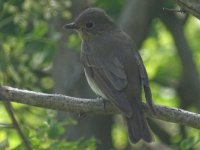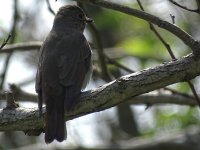The paper by Leader and Carey that Grahame posted was very interesting. Like House Crow, I had not been aware of the Zappey's split, or at least not paid attention to it.
Here are a couple of comments to what has been posted after looking at this paper - NB I'm not trying to add any personal expertise, just giving my take on what others have said to calrify the issues for myself and others like me who may be interested.
This paper makes the case that there are three groups of birds to consider for Cyanoptila cyanomelana, rather than the two which have been generally recognised.
At the moment, in books that I have and that are likely to be on the shelves of others reading this thread, there is the nominate, breeding in Japan and Kuriles and maybe some coastal continental locations, and then a ssp C. c. cumatilis which breeds in continental locations to far into central China. This is the breakdown in Mark Brazil's book 'Birds of East Asia' (with the added problem that as his book doesn't cover the area, he doesn't mention central China at all).
Leader and Carey argue (and illustrate clearly in my opinion) that the central Chinese population is very different morphologially and in colour from both the Japanese island breeding population and from the continental coastal breeding population, and that the latter two are subspecies of the same species, but that the central Chinese population should be split as a separate species (which is not only morphologically distinct, but geographically disjunct).
L&C propose bringing back a former ssp title for the coastal continental birds of intermedia, and restricting cumatilis to the central Chinese population. They would then separate off cumatilis as Zappey's Flycatcher. (Of course, then the ssp name intermedia would be a bit problematic, as the birds between which this is supposed to be intermediate are no longer the same species.)
Handbook of Birds of the World has adopted this split and re-instated intermedia.
The Japanese name for cumatilis has been 'Chōsen Oruri' where Oruri is Blue-and White Flycatcher, and Chōsen means 'Korean'. Chōsen is often used in Japan to indicate a continental ssp or sp closely related to a Japanese bird. I cannot point to a source, but I strongly suspect that any Japanese records for 'Zappey's' are in fact for the intermedia, and not for the central Chinese birds at all.
I have only one Japanese book (in Japanese from 2016) which mentions Zappey's and it states that 'recently Chōsen Oruri has been renamed as Zappey's Flycatcher'; the illustration this book gives of this latter seems clearly to be of intermedia, and it states that there is one record from Kuroshima off the coast of southern Kyushu, and 'a few other records from Hegura, Tobishima and elsewhere' which are 'thought to be' this ssp. (The male of nominate and intermedia are surely very difficult to tell apart in the field on view alone, and the female impossible.)
The 2013 edition (Japanese) of Maki's generally respected Photographic Guide (Japan's Wild Birds 650) doesn't mention any ssp at all (i.e. no cumatilis, let alone intermedia), even though B&W Flycatcher is the main bird on the front cover of the book, but the distribution map also doesn't indicate any presence in central China.
The bird in Brazil's Birds of East Asia illustrated and described as cumatilis is clearly L&C's intermedia. As noted L&C's cumatilis would fall outside the range of Brazil's book.)
In short, I think that the likelihood of Zappey's in Japan, in the restricted sense of L&C and of HBW is very low even in Hegurajima; indeed it's probably never been seen. But I can't point to any source to confirm this, so I might be wrong.
After writing the above, I remembered a post on Neil Davidson's Japanese birding blog about a
possible intermedia on Hegurajima in 2014. If I'd remembered it earlier, perhaps I would have just given the link, without writing my post, but having gone to the trouble, I'll leave my stuff up, as I think it's correct anyway.






